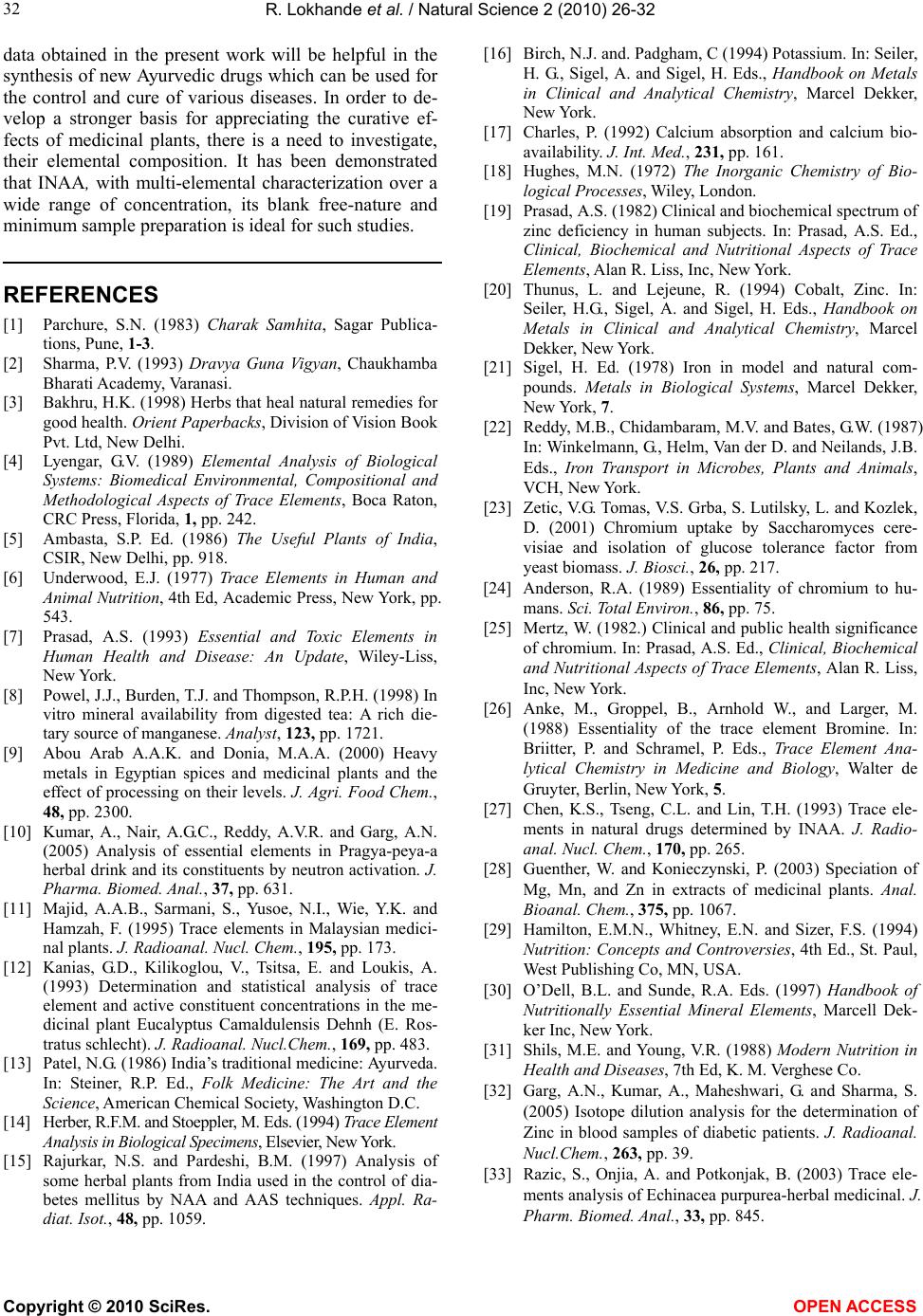
R. Lokhande et al. / Natural Science 2 (2010) 26-32
Copyright © 2010 SciRes. OPEN ACCESS
32
data obtained in the present work will be helpful in the
synthesis of new Ayurvedic drugs which can be used for
the control and cure of various diseases. In order to de-
velop a stronger basis for appreciating the curative ef-
fects of medicinal plants, there is a need to investigate,
their elemental composition. It has been demonstrated
that INAA, with multi-elemental characterization over a
wide range of concentration, its blank free-nature and
minimum sample preparation is ideal for such studies.
REFERENCES
[1] Parchure, S.N. (1983) Charak Samhita, Sagar Publica-
tions, Pune, 1-3.
[2] Sharma, P.V. (1993) Dravya Guna Vigyan, Chaukhamba
Bharati Academy, Varanasi.
[3] Bakhru, H.K. (1998) Herbs that heal natural remedies for
good health. Orient Paperbacks, Division of Vision Book
Pvt. Ltd, New Delhi.
[4] Lyengar, G.V. (1989) Elemental Analysis of Biological
Systems: Biomedical Environmental, Compositional and
Methodological Aspects of Trace Elements, Boca Raton,
CRC Press, Florida, 1, pp. 242.
[5] Ambasta, S.P. Ed. (1986) The Useful Plants of India,
CSIR, New Delhi, pp. 918.
[6] Underwood, E.J. (1977) Trace Elements in Human and
Animal Nutrition, 4th Ed, Academic Press, New York, pp.
543.
[7] Prasad, A.S. (1993) Essential and Toxic Elements in
Human Health and Disease: An Update, Wiley-Liss,
New York.
[8] Powel, J.J., Burden, T.J. and Thompson, R.P.H. (1998) In
vitro mineral availability from digested tea: A rich die-
tary source of manganese. Analyst, 123, pp. 1721.
[9] Abou Arab A.A.K. and Donia, M.A.A. (2000) Heavy
metals in Egyptian spices and medicinal plants and the
effect of processing on their levels. J. Agri. Food Chem.,
48, pp. 2300.
[10] Kumar, A., Nair, A.G.C., Reddy, A.V.R. and Garg, A.N.
(2005) Analysis of essential elements in Pragya-peya-a
herbal drink and its constituents by neutron activation. J.
Pharma. Biomed. Anal., 37, pp. 631.
[11] Majid, A.A.B., Sarmani, S., Yusoe, N.I., Wie, Y.K. and
Hamzah, F. (1995) Trace elements in Malaysian medici-
nal plants. J. Radioanal. Nucl. Chem., 195, pp. 173.
[12] Kanias, G.D., Kilikoglou, V., Tsitsa, E. and Loukis, A.
(1993) Determination and statistical analysis of trace
element and active constituent concentrations in the me-
dicinal plant Eucalyptus Camaldulensis Dehnh (E. Ros-
tratus schlecht). J. Radioanal. Nucl.Chem., 169, pp. 483.
[13] Patel, N.G. (1986) India’s traditional medicine: Ayurveda.
In: Steiner, R.P. Ed., Folk Medicine: The Art and the
Science, American Chemical Society, Washington D.C.
[14] Herber, R.F.M. and Stoeppler, M. Eds. (1994) Trace Element
Analysis in Biological Specimens, Elsevier, New York.
[15] Rajurkar, N.S. and Pardeshi, B.M. (1997) Analysis of
some herbal plants from India used in the control of dia-
betes mellitus by NAA and AAS techniques. Appl. Ra-
diat. Isot., 48, pp. 1059.
[16] Birch, N.J. and. Padgham, C (1994) Potassium. In: Seiler,
H. G., Sigel, A. and Sigel, H. Eds., Handbook on Metals
in Clinical and Analytical Chemistry, Marcel Dekker,
New York.
[17] Charles, P. (1992) Calcium absorption and calcium bio-
availability. J. Int. Med., 231, pp. 161.
[18] Hughes, M.N. (1972) The Inorganic Chemistry of Bio-
logical Processes, Wiley, London.
[19] Prasad, A.S. (1982) Clinical and biochemical spectrum of
zinc deficiency in human subjects. In: Prasad, A.S. Ed.,
Clinical, Biochemical and Nutritional Aspects of Trace
Elements, Alan R. Liss, Inc, New York.
[20] Thunus, L. and Lejeune, R. (1994) Cobalt, Zinc. In:
Seiler, H.G., Sigel, A. and Sigel, H. Eds., Handbook on
Metals in Clinical and Analytical Chemistry, Marcel
Dekker, New York.
[21] Sigel, H. Ed. (1978) Iron in model and natural com-
pounds. Metals in Biological Systems, Marcel Dekker,
New York, 7.
[22] Reddy, M.B., Chidambaram, M.V. and Bates, G.W. (1987)
In: Winkelmann, G., Helm, Van der D. and Neilands, J.B.
Eds., Iron Transport in Microbes, Plants and Animals,
VCH, New York.
[23] Zetic, V.G. Tomas, V.S. Grba, S. Lutilsky, L. and Kozlek,
D. (2001) Chromium uptake by Saccharomyces cere-
visiae and isolation of glucose tolerance factor from
yeast biomass. J. Biosci., 26, pp. 217.
[24] Anderson, R.A. (1989) Essentiality of chromium to hu-
mans. Sci. Total Environ., 86, pp. 75.
[25] Mertz, W. (1982.) Clinical and public health significance
of chromium. In: Prasad, A.S. Ed., Clinical, Biochemical
and Nutritional Aspects of Trace Elements, Alan R. Liss,
Inc, New York.
[26] Anke, M., Groppel, B., Arnhold W., and Larger, M.
(1988) Essentiality of the trace element Bromine. In:
Briitter, P. and Schramel, P. Eds., Trace Element Ana-
lytical Chemistry in Medicine and Biology, Walter de
Gruyter, Berlin, New York, 5.
[27] Chen, K.S., Tseng, C.L. and Lin, T.H. (1993) Trace ele-
ments in natural drugs determined by INAA. J. Radio-
anal. Nucl. Chem., 170, pp. 265.
[28] Guenther, W. and Konieczynski, P. (2003) Speciation of
Mg, Mn, and Zn in extracts of medicinal plants. Anal.
Bioanal. Chem., 375, pp. 1067.
[29] Hamilton, E.M.N., Whitney, E.N. and Sizer, F.S. (1994)
Nutrition: Concepts and Controversies, 4th Ed., St. Paul,
West Publishing Co, MN, USA.
[30] O’Dell, B.L. and Sunde, R.A. Eds. (1997) Handbook of
Nutritionally Essential Mineral Elements, Marcell Dek-
ker Inc, New York.
[31] Shils, M.E. and Young, V.R. (1988) Modern Nutrition in
Health and Diseases, 7th Ed, K. M. Verghese Co.
[32] Garg, A.N., Kumar, A., Maheshwari, G. and Sharma, S.
(2005) Isotope dilution analysis for the determination of
Zinc in blood samples of diabetic patients. J. Radioanal.
Nucl.Chem., 263, pp. 39.
[33] Razic, S., Onjia, A. and Potkonjak, B. (2003) Trace ele-
ments analysis of Echinacea purpurea-herbal medicinal. J.
Pharm. Biomed. Anal., 33, pp. 845.